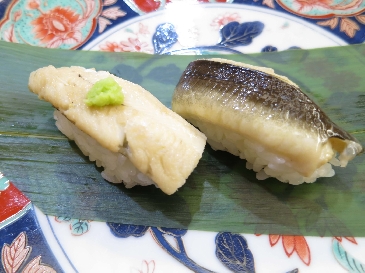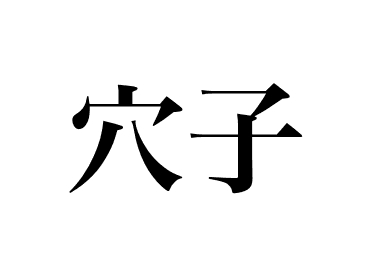Simmered


Japanese conger (Anago)
【Nigiri sushi: Nimono】
What is Japanese conger (Anago)?
More than 20 species of anago have been identified worldwide. Among them, the most commonly used for sushi are Goten-anago (Silvery conger) and Kuro-anago (Beach conger), which are found mainly in southern Japan, and Ma-anago (Japanese conger), which is said to be the most suitable for nigiri sushi. When anago is mentioned in Edomae sushi restaurants, it refers to Ma-anago.
There is an old saying that “The best Conger eel is from Edomae (the old name for Tokyo Bay)” and even now, the conger eel found in the seas off of Haneda (in front of Tokyo International Airport), is considered to be high quality, but they are not available in high quantities and aren’t often put on the market. However, besides the seas off of Haneda, the conger eel found in Tokyo Bay, such as in Kanazawa-hakkei, Kanagawa prefecture, or Kisarazu and Futtsu, Chiba prefecture, also have good flavor. Conger eel itself is found throughout Japan, from Hokkaido southward. They are often caught in Tsushima, Nagasaki prefecture and the Seto Inland Sea. In recent years they are also imported from South Korea and China.
This is one topping that can be enjoyed year-round, but is especially delicious from June to July when the conger eel is fattier. This is said to be because the rainy season allows nutrients to flow through the rivers into the sea, increasing the food supply and making the eel more delicious. It is interesting that although grilled conger eel is made into sushi at Kansai sushi restaurants, boiled conger eel is the general topping in Kanto.
When Yohei Hanaya, the founder of Edo-style sushi, first opened shop, it is said that he added boiled conger eel as a topping when he added clams and tiger prawns as toppings. Since conger eel has been used as a sushi topping since Edo-style sushi was born, special attention to detail is given in the preparations, and each shop comes up with its own unique flavor.
What does Anago (Japanese conger) nigiri sushi taste like?
When you put the boiled Anago in your mouth, it melts softly and the fine fat gently envelops your tongue. You can eat it with salt or with sweet Tsume. You can also lightly sear it when making nigiri sushi and fill your mouth with the melted fat.
The navel (actually the anus) in the middle of the body serves as the border separating the head part (top) and tail part (bottom) of the eel. The fat is distributed better on the top. People used to say that since the bottom moves more it is tastier. Also often said, “the top should be served skin-up and the bottom should be served skin-down.” Skin-up means that the skin side is on top and the meaty side is on the rice. Skin-down means that the meaty side is facing up and the skin side is on the rice. Anago easily melts apart when it is boiled and if nitsume is applied here, it enters the part where it separates, so the appearance is not as appealing. But unless the crack is extremely obvious, both the top and bottom of the conger eel are often prepared skin-down in sushi.
Also called White-spotted conger or Conger eel or saltwater eel.
【Preparation method】
The traditional preparation method is to boil the conger eel without removing the slime from its surface. However, different sushi chefs use different methods of preparation, such as removing the slime after the conger eel has been cleaned.
【Substitute fish】
Punctuated snake-eel: Ophichthus remiger
Kaup's arrowtooth eel: Synaphobranchus kaupii Johnson, 1862
Deep-sea fish, Ira-anago (Kaup's arrowtooth eel), is now widely distributed mainly in supermarkets in the Tokyo metropolitan area. As the catch of Japanese conger (Ma -anago) has been drastically reduced, it has come into the limelight as a "substitute" fish.
【Related contents】
About anago, there are two way to make sushi, “skin-up ” and “skin-down”.
Why are two pieces of nigiri sushi made at once?
What is Noresore sushi?
List of Nimono, Gyoran and Others
(Revision date: January 26, 2024)
Main production area
TokyoBay Kyushu
Famous production area
Season
Summer

